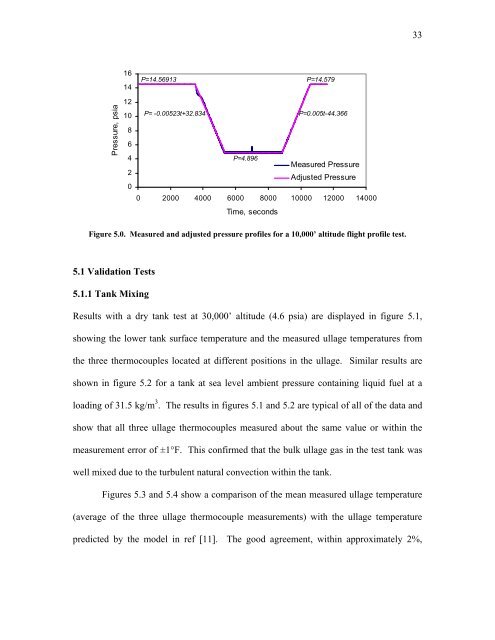Vaporization of JP-8 Jet Fuel in a Simulated Aircraft Fuel Tank ...
Vaporization of JP-8 Jet Fuel in a Simulated Aircraft Fuel Tank ...
Vaporization of JP-8 Jet Fuel in a Simulated Aircraft Fuel Tank ...
You also want an ePaper? Increase the reach of your titles
YUMPU automatically turns print PDFs into web optimized ePapers that Google loves.
Pressure, psia<br />
16<br />
14<br />
12<br />
10<br />
8<br />
6<br />
4<br />
2<br />
0<br />
P=14.56913<br />
P= -0.00523t+32.834<br />
P=4.896<br />
0 2000 4000 6000 8000 10000 12000 14000<br />
Time, seconds<br />
P=14.579<br />
P=0.005t-44.366<br />
Measured Pressure<br />
Adjusted Pressure<br />
Figure 5.0. Measured and adjusted pressure pr<strong>of</strong>iles for a 10,000’ altitude flight pr<strong>of</strong>ile test.<br />
5.1 Validation Tests<br />
5.1.1 <strong>Tank</strong> Mix<strong>in</strong>g<br />
Results with a dry tank test at 30,000’ altitude (4.6 psia) are displayed <strong>in</strong> figure 5.1,<br />
show<strong>in</strong>g the lower tank surface temperature and the measured ullage temperatures from<br />
the three thermocouples located at different positions <strong>in</strong> the ullage. Similar results are<br />
shown <strong>in</strong> figure 5.2 for a tank at sea level ambient pressure conta<strong>in</strong><strong>in</strong>g liquid fuel at a<br />
load<strong>in</strong>g <strong>of</strong> 31.5 kg/m 3 . The results <strong>in</strong> figures 5.1 and 5.2 are typical <strong>of</strong> all <strong>of</strong> the data and<br />
show that all three ullage thermocouples measured about the same value or with<strong>in</strong> the<br />
measurement error <strong>of</strong> ±1°F. This confirmed that the bulk ullage gas <strong>in</strong> the test tank was<br />
well mixed due to the turbulent natural convection with<strong>in</strong> the tank.<br />
Figures 5.3 and 5.4 show a comparison <strong>of</strong> the mean measured ullage temperature<br />
(average <strong>of</strong> the three ullage thermocouple measurements) with the ullage temperature<br />
predicted by the model <strong>in</strong> ref [11]. The good agreement, with<strong>in</strong> approximately 2%,<br />
33
















